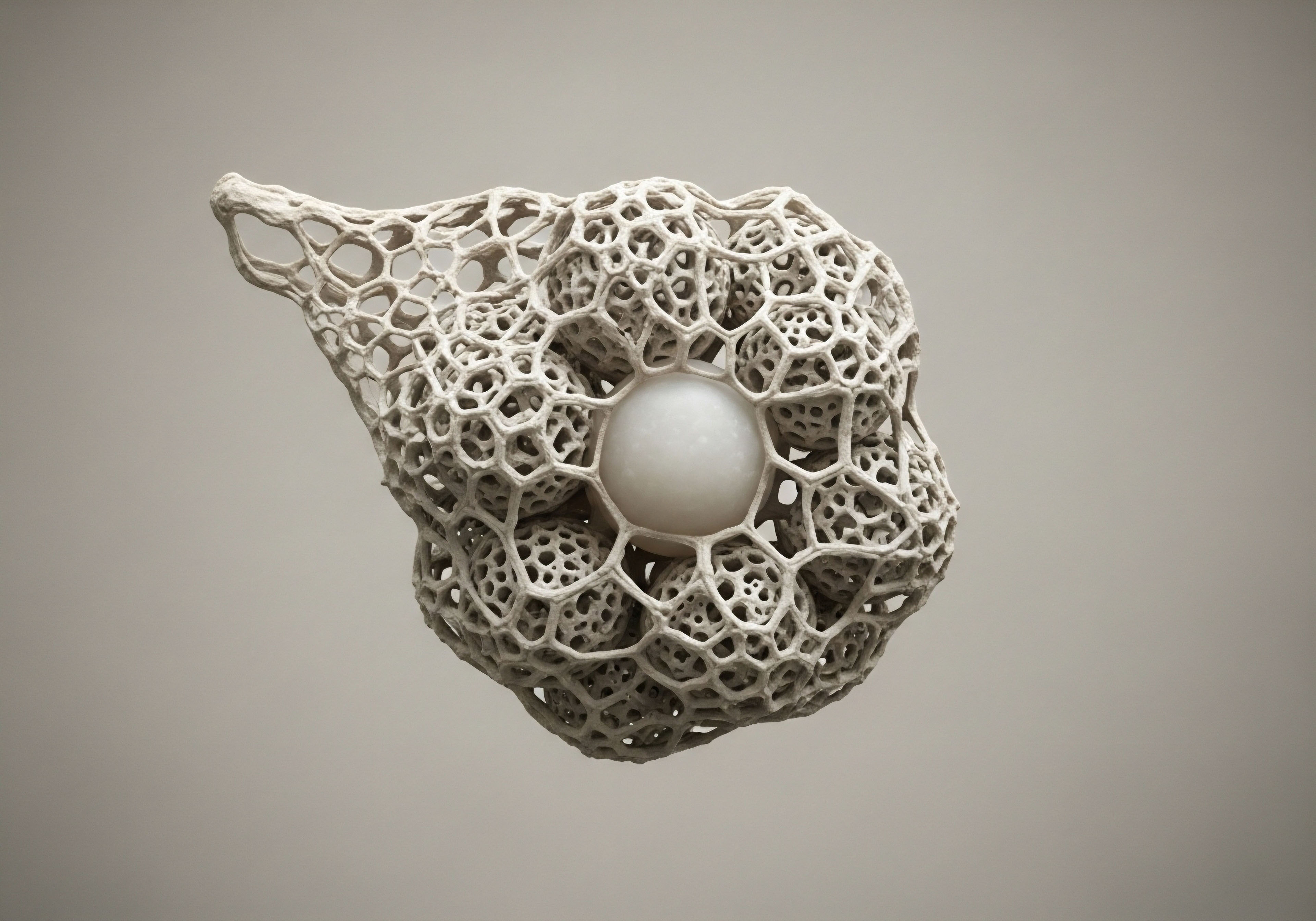

Fundamentals
You feel it as a subtle shift in your body’s internal rhythm. The energy that once propelled you through demanding days now seems to wane sooner. Recovery from physical exertion takes longer, and a certain resilience you took for granted feels diminished.
This experience, a common narrative in adult life, often originates deep within our body’s intricate communication network ∞ the endocrine system. Understanding this system is the first step toward addressing these changes with precision and intelligence. Your body operates on a complex series of instructions, and hormones are the messengers carrying these vital commands. Among the most important of these is growth hormone (GH), the master signal for cellular repair, regeneration, and metabolism.
The production of growth hormone is a beautifully orchestrated process managed by the hypothalamic-pituitary axis, a central command center in the brain. The hypothalamus releases a specific signal, Growth Hormone Releasing Hormone (GHRH), which travels a short distance to the pituitary gland. In response, the pituitary releases a pulse of growth hormone into the bloodstream.
This GH then circulates throughout the body, binding to receptors in various tissues, including muscle, bone, and fat. A primary action of GH is to stimulate the liver to produce another powerful signaling molecule, Insulin-like Growth Factor 1 (IGF-1), which is responsible for many of the widespread anabolic and restorative effects we associate with GH.
The entire process functions as a sophisticated feedback loop, ensuring that hormone levels are maintained within a healthy, functional range.
Growth Hormone Releasing Peptides (GHRPs) represent a refined therapeutic approach that works in harmony with this natural axis. This category includes molecules like Sermorelin, Ipamorelin, and Tesamorelin. They act as precise signaling tools. Sermorelin, for instance, is a structural analog of the body’s own GHRH, directly stimulating the pituitary to produce and release its own growth hormone.
Ipamorelin and similar peptides, known as ghrelin mimetics or growth hormone secretagogues (GHS), work through a parallel pathway, also resulting in a potent, clean pulse of GH release. This approach respects the body’s innate biological rhythms, promoting a more natural pattern of hormone elevation.
The cardiovascular system is a primary beneficiary of this hormonal axis. The heart and the vast network of blood vessels are replete with receptors for both GH and IGF-1. These hormones directly influence the strength of the heart muscle, the health and flexibility of blood vessel linings, and the regulation of blood pressure.
When the GH system is functioning optimally, it contributes to maintaining cardiac structure and promoting efficient blood flow. Therefore, exploring the influence of GHRPs on this system is a logical step for anyone seeking to support long-term cardiovascular wellness and vitality.


Intermediate
To appreciate how Growth Hormone Releasing Peptides (GHRPs) can affect cardiovascular health, we must examine the specific biological mechanisms through which growth hormone (GH) and its primary mediator, IGF-1, act upon the heart and vasculature. The influence is comprehensive, affecting everything from the cellular health of blood vessel walls to the contractile efficiency of the heart muscle itself. These are not broad, generalized effects; they are specific, measurable physiological actions that underscore the connection between endocrine balance and cardiovascular function.

The Role of GH in Endothelial Health
The endothelium is the thin layer of cells lining the interior of all blood vessels. Its health is paramount for cardiovascular wellness. A key function of healthy endothelial cells is the production of nitric oxide (NO), a potent vasodilator that relaxes blood vessels, improves blood flow, and helps regulate blood pressure.
GH and IGF-1 have been shown to directly stimulate endothelial nitric oxide synthase (eNOS), the enzyme responsible for producing NO. By promoting adequate NO production, an optimized GH axis helps maintain vascular elasticity and responsiveness, which is fundamental to preventing arterial stiffness, a hallmark of age-related cardiovascular decline. This mechanism contributes directly to improved peripheral circulation and can have a favorable impact on blood pressure regulation.

Impact on Cardiac Structure and Performance
The heart muscle, or myocardium, is highly responsive to GH and IGF-1. These signaling molecules promote what is known as physiological cardiac hypertrophy. This involves the healthy growth of heart muscle cells (cardiomyocytes), leading to an increase in the thickness of the left ventricular wall, the heart’s main pumping chamber.
This adaptation allows the heart to pump blood more forcefully and efficiently with each beat, improving cardiac output. Epidemiological studies in individuals with Growth Hormone Deficiency (GHD) often reveal a reduced left ventricular mass and impaired pumping function, conditions that can be improved with carefully monitored hormone replacement therapy. The goal of GHRP therapy is to restore these levels to a youthful, optimal range, thereby supporting the heart’s structural integrity and functional capacity.
An optimized GH axis supports the heart’s physical structure and its functional efficiency, directly impacting stamina and performance.

Modulation of Inflammation and Metabolic Markers
Chronic, low-grade inflammation is a known driver of atherosclerosis, the process of plaque buildup in arteries. The GH/IGF-1 axis exerts a moderating influence on inflammatory processes. Studies have indicated that normalizing GH levels can lead to a reduction in certain inflammatory biomarkers, such as C-reactive protein (CRP), a protein that is widely used as a clinical marker of systemic inflammation.
Furthermore, the metabolic effects of GH are significant. It promotes the breakdown of triglycerides (fats) and can influence cholesterol levels. While the relationship is complex and dose-dependent, maintaining physiological GH levels is generally associated with a more favorable lipid profile, including effects on apolipoprotein B (ApoB), a key component of LDL cholesterol.

Comparing States of GH Influence on the Cardiovascular System
The effects of growth hormone are highly dependent on its concentration. Both deficiency and excess create distinct cardiovascular risks, while physiological optimization supports wellness. Understanding this spectrum is key to appreciating the goal of peptide therapy.
| Cardiovascular Parameter | GH Deficiency (GHD) | Optimal GH Levels | GH Excess (Acromegaly) |
|---|---|---|---|
| Left Ventricular Mass |
Decreased |
Normal, healthy mass |
Pathological hypertrophy, diastolic dysfunction |
| Endothelial Function (NO Production) |
Impaired |
Supported and efficient |
Initially enhanced, but can decline with comorbidities |
| Blood Pressure |
Often increased diastolic pressure |
Normalized |
Hypertension is common |
| Lipid Profile |
Elevated LDL cholesterol and triglycerides |
Favorable profile |
Variable, but often associated with insulin resistance |
| Inflammatory Markers (e.g. CRP) |
Often elevated |
Lowered or normalized |
Can be elevated due to metabolic stress |

Common Growth Hormone Releasing Peptides
Different peptides are selected based on their specific mechanism of action and therapeutic goals. While all aim to increase GH production, their methods and secondary effects can differ.
- Sermorelin ∞ As a GHRH analogue, it directly stimulates the pituitary gland. Its action is governed by the body’s natural feedback mechanisms, making it a very safe and physiological approach to restoring GH levels.
- Ipamorelin / CJC-1295 ∞ This popular combination leverages two different mechanisms. CJC-1295 is a GHRH analogue with a longer half-life, providing a steady stimulatory signal. Ipamorelin is a selective ghrelin mimetic (GHS) that induces a strong, clean pulse of GH without significantly affecting other hormones like cortisol or prolactin.
- Tesamorelin ∞ This is a potent GHRH analogue specifically studied and approved for reducing visceral adipose tissue (VAT) in certain populations. Its ability to target metabolically active fat has direct implications for improving cardiovascular risk factors.


Academic
A sophisticated examination of the relationship between growth hormone releasing peptides and cardiovascular health moves beyond the systemic effects of GH and IGF-1. It requires an investigation into the direct, localized actions of these peptides on cardiac and vascular tissues.
Emerging research indicates that the heart is not merely a passive recipient of hormonal signals from the pituitary; it is an active participant with its own local signaling systems. This understanding opens a new therapeutic paradigm, suggesting that some peptides may confer cardioprotective benefits independent of their role as simple secretagogues.

Do GHRH Agonists Offer Cardioprotection beyond the GH Axis?
The most compelling evidence for this direct action comes from preclinical studies using potent GHRH agonists (GHRH-A). In animal models of myocardial infarction (MI), treatment with a GHRH-A was shown to significantly improve cardiac structure and function, reduce the size of the infarct, and decrease cardiac fibrosis.
Crucially, these profound benefits occurred without any corresponding elevation in the circulating levels of either GH or IGF-1. This finding strongly supports the hypothesis that GHRH agonists can exert direct protective effects on the heart muscle. The mechanism appears to involve the activation of GHRH receptors that are expressed locally on cardiomyocytes themselves. This direct activation can trigger intracellular signaling cascades that promote cell survival and mitigate the pathological remodeling that typically follows a heart attack.
In stark contrast, the same studies showed that administering high doses of recombinant growth hormone (rrGH) did not produce the same cardioprotective effects. While rrGH did increase body weight and circulating GH/IGF-1 levels as expected, it failed to prevent the decline in cardiac function or the adverse remodeling seen in the placebo group.
This dissociation of effects is a critical point. It suggests that the therapeutic goal for cardiovascular protection may involve activating local GHRH receptors within the heart tissue, an action that GHRPs are uniquely suited to perform.

Molecular Pathways and Cellular Mechanisms
The signaling within a heart cell following GHRH receptor activation is complex. It is thought to involve pathways that are central to cell survival and resistance to injury. These may include the PI3K/Akt pathway, a well-known pro-survival cascade that inhibits apoptosis (programmed cell death), and other signaling molecules that reduce oxidative stress and inflammation within the damaged myocardial tissue.
The reduction in cardiac fibrosis observed in GHRH-A treated animals is particularly significant. Fibrosis, the formation of scar tissue, leads to a stiffer, less compliant heart muscle, which is a primary driver of diastolic dysfunction and a major contributor to the progression of heart failure. By mitigating fibrosis, GHRH agonists help preserve the heart’s mechanical properties and long-term function.
The discovery of local GHRH receptors in the heart reframes peptides as potential direct-acting cardioprotective agents, not just hormone stimulants.
This line of research also helps to contextualize the mixed results seen in large clinical trials that used high-dose recombinant human GH (rhGH) to treat patients with chronic heart failure. Some early, small-scale trials suggested benefits, but larger, placebo-controlled studies largely failed to show improvements in cardiac function and, in some critical care settings, were associated with increased morbidity.
The direct administration of GH bypasses the body’s nuanced feedback loops and can lead to supraphysiological levels that induce adverse effects, including insulin resistance and fluid retention. Peptide therapies, particularly those like GHRH agonists, may offer a more targeted and safer approach by leveraging these direct, localized protective mechanisms while promoting a more physiological pattern of GH release.

Summary of Key Preclinical and Clinical Findings
The evolution of research from direct GH administration to the use of releasing peptides reflects a growing sophistication in our understanding of the GH axis and cardiovascular health.
| Therapeutic Agent | Study Population / Model | Key Cardiovascular Findings | Reference |
|---|---|---|---|
| Recombinant Human GH (rhGH) |
Patients with dilated cardiomyopathy |
Increased left ventricular mass but no significant improvement in LV function or clinical status in larger trials. |
|
| GHRH Agonist (e.g. JI-38) |
Rat model of myocardial infarction |
Improved cardiac function, reduced infarct size, and decreased cardiac fibrosis, without elevating systemic GH/IGF-1. |
|
| GH Replacement Therapy |
Adults with GH Deficiency (GHD) |
Increased LV mass, improved LV function, reduced diastolic blood pressure, and improved exercise capacity. |
|
| GH/IGF-1 |
Animal models of heart failure |
Increased cardiac output and decreased systemic vascular resistance. |

Key Signaling Pathways in Cardiac Tissue
The response of heart cells to GH, IGF-1, and GHRH is mediated by distinct intracellular signaling cascades. Understanding these pathways is essential for developing targeted therapies.
- JAK/STAT Pathway ∞ The classical pathway for GH receptor signaling. Activation of this pathway is crucial for GH-induced gene expression related to cell growth and proliferation.
- PI3K/Akt Pathway ∞ A central node for both IGF-1 and GHRH receptor signaling. This pro-survival pathway is heavily implicated in promoting cardiomyocyte survival, inhibiting apoptosis, and mediating healthy, physiological hypertrophy.
- MAPK/ERK Pathway ∞ Another pathway activated by GH and IGF-1, involved in regulating cell growth and differentiation. Its over-activation can sometimes be linked to pathological hypertrophy.
The future of peptide therapy for cardiovascular health will likely focus on developing molecules that can selectively activate these protective pathways within the heart tissue itself, while minimizing off-target effects and avoiding the risks associated with chronically elevated systemic GH levels. This represents a more nuanced and biologically intelligent approach to long-term wellness.

References
- Bagno, F. et al. “Cardioprotective effects of growth hormone-releasing hormone agonist after myocardial infarction.” Proceedings of the National Academy of Sciences, vol. 106, no. 6, 2009, pp. 1969-1974.
- Pivonello, R. et al. “Growth Hormone (GH) and Cardiovascular System.” International Journal of Molecular Sciences, vol. 20, no. 13, 2019, p. 3194.
- Tivesten, Å. et al. “Cardiac and peripheral actions of growth hormone and its releasing peptides ∞ Relevance for the treatment of cardiomyopathies.” Cardiovascular Research, vol. 69, no. 1, 2006, pp. 26-35.
- Kittleson, M. D. “Growth hormone-releasing peptides and the heart ∞ secretagogues or cardioprotectors?” Cardiovascular Research, vol. 49, no. 3, 2001, pp. 483-485.
- WebMD. “Human Growth Hormone (HGH) ∞ Benefits, Risks, and Uses.” 2 May 2024.

Reflection

Calibrating Your Internal Systems
The information presented here provides a map of the intricate biological landscape connecting peptide therapies to cardiovascular health. This map details the pathways, the mechanisms, and the potential destinations. Yet, a map is only a guide. The actual territory is your own unique physiology, with its distinct history, genetics, and present condition.
The true value of this knowledge lies in its application as a tool for a more profound conversation, one you have first with yourself, and then with a clinical expert who can help you interpret your body’s specific signals.
Consider the concept of biological resonance. The goal of any advanced wellness protocol is to restore a state of functional harmony, where the body’s internal messaging systems operate with the clarity and efficiency they were designed for. The journey begins with listening ∞ to the subtle cues your body provides daily and to the objective data revealed through comprehensive lab work.
Viewing your health through this lens transforms it from a series of isolated symptoms into a single, interconnected system. The path forward is one of calibration, making precise adjustments to restore balance and reclaim the vitality that is your biological birthright.



